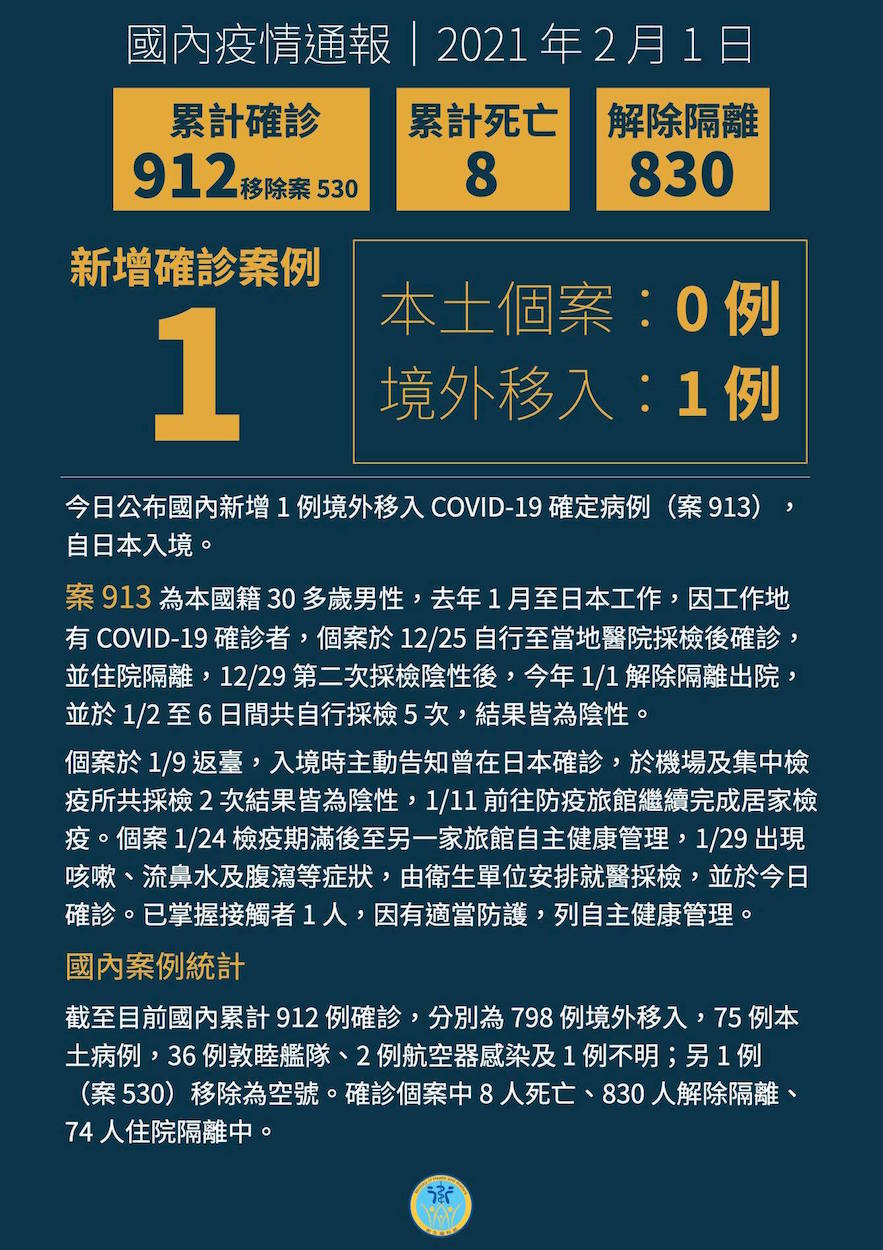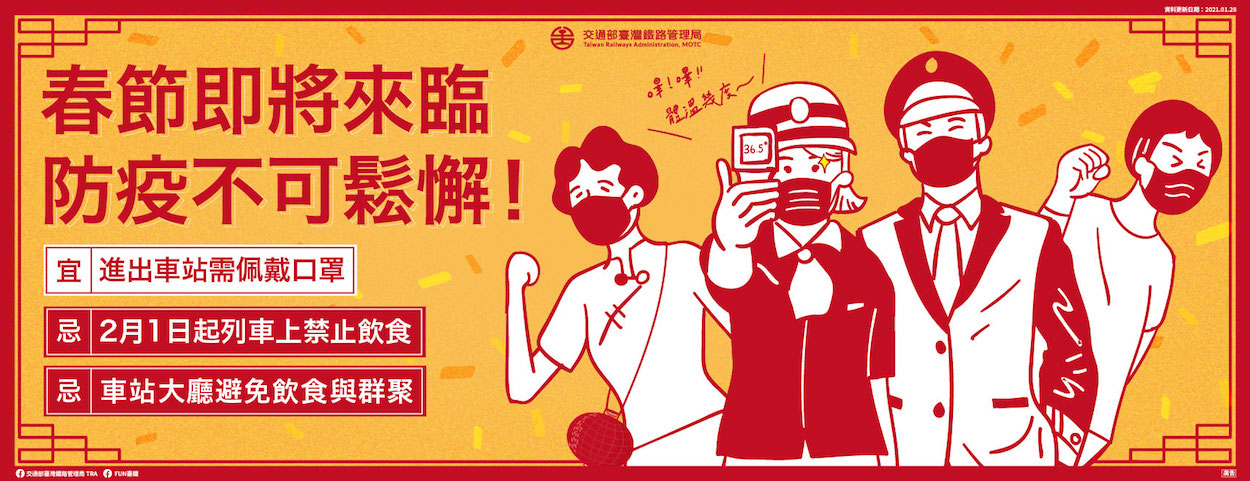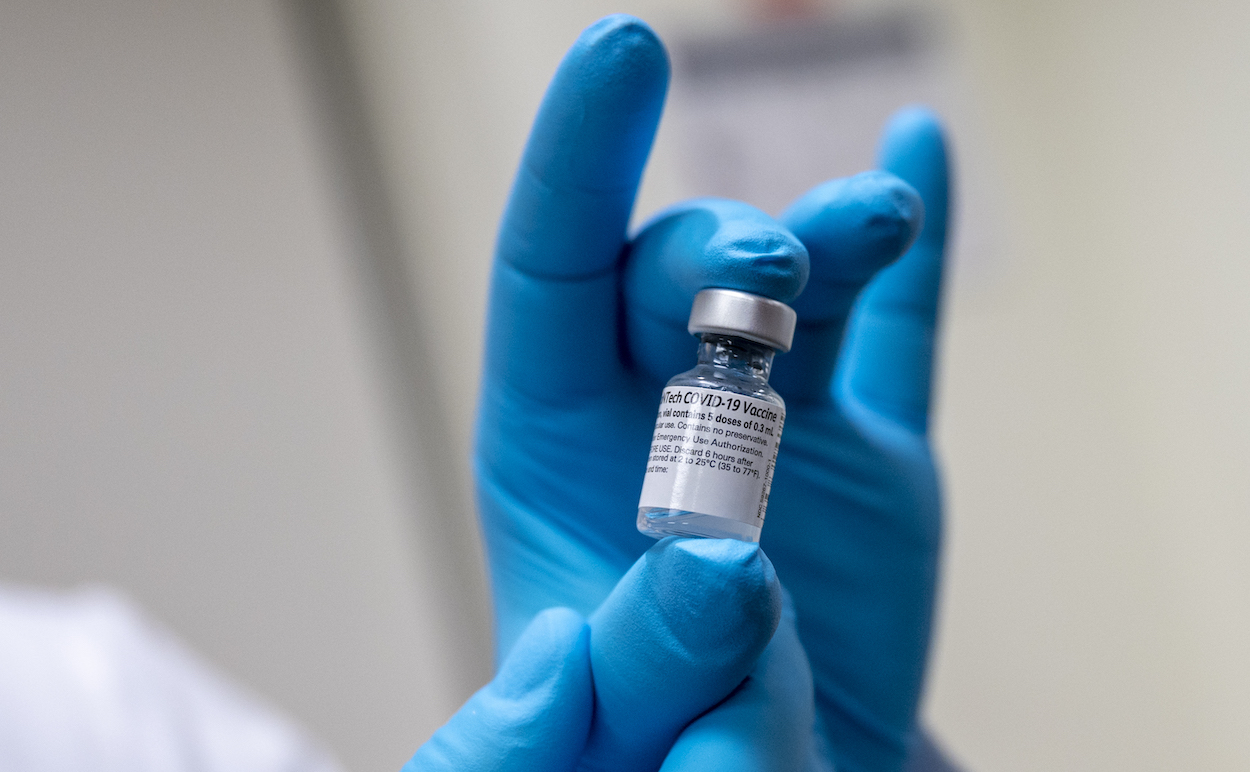by Brian Hioe
語言:
English
Photo Credit: Presidential Office/Flickr/CC
THE SITUATION regarding the Taoyuan General Hospital cluster, Taiwan’s first COVID-19 cluster since last April and Taiwan’s largest COVID-19 cluster to date, continues to develop.
Friday night saw the first COVID-19 death in eight months, after a woman in her eighties part of the cluster died, and was found to have been infected with COVID-19 after her death. The woman who died was the mother of a nurse who had become infected while working at the hospital, who had preexisting conditions. News of the death broke on Saturday.
It is to be seen while there will be other deaths linked to the Taoyuan cluster. Another one of the Taoyuan cluster is a man in his nineties. However, it is to be noted that Taiwan has only had a total of eight deaths linked to COVID-19, with a total of 912 cases to date.
 Infographic released by the Ministry of Health and Welfare providing updates on the COVID-19 situation for today. Photo credit: Ministry of Health and Welfare
Infographic released by the Ministry of Health and Welfare providing updates on the COVID-19 situation for today. Photo credit: Ministry of Health and Welfare
Optimistic views have hoped that the cluster infection would end within two weeks. While Taiwan saw a streak of four days without any new cases of domestic transmission last week, this came to an end after four new domestic cases were reported over the weekend, all linked to the Taoyuan cluster. The Taoyuan cluster is currently at nineteen individuals.
Those four cases were already in quarantine, with the Central Epidemic Command Center (CECC) that directs Taiwan’s response to COVID-19 having ordered patients that were discharged from the Taoyuan General Hospital between January 6th and 19th and their contacts into quarantine on January 24th.
However, the CECC has publicized the movements of a man part of the Taoyuan cluster who visited the Jiufen Old Street and restaurants in New Taipei before he was listed as a contact of one of the cases from the Taoyuan cluster went into quarantine. The CECC has stated that the man was not likely to have been infectious during this time.
To this extent, the CECC has stated that cases from the Taoyuan cluster have been found to all share the same strain of COVID-19. This allays fears regarding that one of the cases linked to the Taoyuan cluster had a previously unknown source of infection; the case in question was later found to have a similar genetic makeup to other strains from the hospital.
Measures to prevent the spread of COVID-19 have been stepped up after the Taoyuan cluster. A ban on eating and drinking on trains and buses has been reimposed, while Taipei, New Taipei, and Taoyuan have banned hospital visits until February 9th. The CECC has also increased subsidies for medical personnel and facilities involved in treating COVID-19 cases, with some subsidies aimed specifically at those involved in treating the Taoyuan cluster, and some subsidies applying to COVID-19 patients not part of the Taoyuan cluster.
 Image released by the Taiwan Railways Administration announcing the new regulations. Photo credit: Taiwan Railways Administration/Facebook
Image released by the Taiwan Railways Administration announcing the new regulations. Photo credit: Taiwan Railways Administration/Facebook
With several thousand individuals under home quarantine because of measures taken to prevent the spread of the COVID-19 cluster, it is also anticipated that Taiwan will see imported cases of COVID-19 due to returnees for the Lunar New Year. Taiwan has continued to see new imported cases in the past few weeks and there have been concerns about whether returnees will overburden Taiwan’s quarantine facilities. As a result, government quarantine centers were made available for booking, but were quickly filled up, and the government sought to expand the number of available quarantine rooms. Airports such as the Taoyuan International Airport and Songshan Airport have introduced new touchless screens to minimize the possibility of infection.
There has also been some concern about breaches of quarantine facilities, such as of individuals that illegally leave quarantine facilities. Otherwise, there have been cases of studios being illegally rented out as quarantine facilities, despite lacking measures for a safe quarantine. In an unusual story, a man who was previously fined 100,000 NT for breaching quarantine later had his fine retracted, after it was found that he had been forcibly removed from his quarantine facility by loan sharks. Such incidents raise concerns regarding contacts between members of the public and individuals currently undergoing quarantine.
In the meantime, some political contestation has followed suit about Taiwan’s access to COVID-19 vaccines. The CECC has secured access for Taiwan to 4.76 million doses of vaccines through the COVAX program, purchased 10 million doses of the Oxford-AstraZeneca vaccine, and may be in talks with another company to secure another 5 million doses. Nevertheless, the CECC has stated that it expects delays from the European Union regarding accessibility to vaccines, though it has not had any formal response from the European Union yet. It was originally expected that the first vaccines could arrive in Taiwan in March, at the earliest.
This has led to calls from pan-Blue opposition parties, such as the TPP, calling on the government to be more transparent about the current status of Taiwan’s ability to access vaccines. With the suggestion that Taiwan could trade chips produced by local semiconductor companies such as Taiwan Semiconductor Manufacturing Corporation for vaccines gaining traction after being floated by the Taiwan Institute of Economic Research late last month, the KMT has jumped onboard with the idea, and the Tsai administration is currently in talks with Germany regarding the idea.
 Dose of the Pfizer vaccine. Photo credit: US Department of Defense/Flickr/CC
Dose of the Pfizer vaccine. Photo credit: US Department of Defense/Flickr/CC
At the same time, one expects to see the circulation of disinformation regarding Taiwan’s vaccine outlook going forward. The CECC recently denied a front page report from the pan-Blue United Daily News that the government had secured access to 100,000 doses of the Pfizer vaccine through diplomatic channels.
It is to be expected that pan-Blue groups may amplify misinformation and disinformation about how much vaccines have been procured by the Tsai administration, for example, with claims that the Tsai administration is hoarding vaccines for its own use instead of making them available to frontline medical personnel involved in the fight against COVID-19. Such accusations would be ironic, considering that pan-Blue politicians have never felt impeded from throwing medical personnel under the bus during disease outbreaks—as seen in the Taipei Municipal Hoping Hospital incident during the 2003 SARS outbreak or more recent calls to lockdown Taoyuan, despite the situation being far from warranting a lockdown.
It is also probable that Chinese disinformation efforts, which have already sought to establish the narrative of the Tsai administration concealing the full extent of the pandemic in Taiwan, will also use the issue of vaccines as a vector of attack. Pan-Blue outlets are likely to amplify this narrative.

